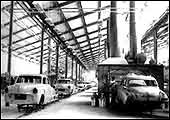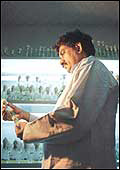|
 For
a revolution to be born, ''there must be a sense of malfunction
that can lead to crisis'', Thomas Samuel Kuhn, the renowned professor
of philosophy at the Massachussets Institute of Technology, once
remarked famously. But in a country where malfunction is chronic
and ennui near-epidemic, how is a revolution to be born? Not of
malfunction, but a crisis. It took 40 lakh lives, two decades of
research, and the threat of imminent famine before the first of
our big ''revolutions'', the Green Revolution, would start winning
in the mid-60s. Similarly, the other remarkable socio-economic revolution,
Operation Flood, found governmental patronage only when it could
no longer be ignored that even as the Indian farmer was starving,
he was being forced to sell precious milk at a pittance to greedy
middlemen. For
a revolution to be born, ''there must be a sense of malfunction
that can lead to crisis'', Thomas Samuel Kuhn, the renowned professor
of philosophy at the Massachussets Institute of Technology, once
remarked famously. But in a country where malfunction is chronic
and ennui near-epidemic, how is a revolution to be born? Not of
malfunction, but a crisis. It took 40 lakh lives, two decades of
research, and the threat of imminent famine before the first of
our big ''revolutions'', the Green Revolution, would start winning
in the mid-60s. Similarly, the other remarkable socio-economic revolution,
Operation Flood, found governmental patronage only when it could
no longer be ignored that even as the Indian farmer was starving,
he was being forced to sell precious milk at a pittance to greedy
middlemen.
But why is it that while mere urge among a
few for a change in status quo will do to fuel a political revolution,
marshalling the economic variety takes much more? The answer perphaps
lies in the divergence of their objectives and means. A political
revolution appeals to emotions, the economic one to reason. The
first destroys, without guaranteeing the new order's utility or
efficacy. The latter creates, it makes no promises, and works within
the existing order, relying on small gains to multiply exponentially
the collective benefit. One feeds on tears and blood, the other
on sweat, ingenuity, and perseverence. Political upheavals alienate
communities, and erode wealth. The ones wrought in a petri dish
or a wafer of silicon, integrate. They create fabulous wealth.
Perhaps, a bigger reason is the limited power
that men yield in influencing revolutions that science brings forth.
It is easy to dispose of an impotent or tyrannical ruler. But how
do you hasten the invention of the steam engine, the computer, the
microprocessor, or the mapping of the human genome? You don't. Economic
revolutions don't happen. They have to be moulded and chiselled
at. Built painstakingly through research, experimentation, failure,
learning and sharing. That's also the reason why their direct pay-offs
are considerably more. Operation Flood, for instance, created Rs
24,000 crore in wealth each year between 1986 and 1996. That's Rs
240,000 crore in a decade alone. At their peaks, India's top four
listed software companies-HCL Technologies, Infosys, Satyam Computers,
and Wipro-created Rs 3,84,730.94 crore in shareholder wealth. By
2008, software exports should be earning India $87 billion (Rs 408,900
crore). The newcomer, still fermenting in up-start laboratories,
could one day fetch as much or more.
It is easy to see where India would have been
without its revolutions. Had a humble geneticist not managed to
cross-breed a Mexican wheat variety with a local seed, India would
probably be living, like somebody said, ship-to-mouth. Had not an
electrical engineer staked claim to his share of the world's growing
software business and, thus, paved the way for others, India may
still be-in the firangi's mind-the land of fakirs and exotic, swarthy
princes. Not the birthplace of Vinod Khosla or N.R. Narayana Murthy.
Revolutions are good. Especially when they are wrought by the power
of brain and not brawn.
The Revolution That Ended
Hunger
 |
| Now, India needs a new revolution to make food
affordable to all of tis poor millions |
Barely four years
ahead of Independence, India witnessed its worst food disaster:
40 lakh people died of hunger in the eastern part of the country,
in what came to be called the Bengal Famine. Not surprisingly, then,
the most important item on Independent India's agenda was food security.
But the government spent the 50s and 60s only trying to bring more
land under cultivation. While foodgrain production went up from
51 million tonnes in 1950 to 82 million in 1960, it wasn't enough
to feed the country's burgeoning population. Another famine on a
larger scale seemed imminent. At the beginning of 1960s what India
needed was an agricultural miracle.
Fortunately for India, a geneticist, Norman
Ernest Borlaug, was winning the battle against hunger in the 1950s.
The high-yield disease-resistant wheat strain Borlaug had developed
was making Mexican farmlands overflow with bumper harvests. By mid-60s,
Borlaug's 'Green Revolution' was established, and he was itching
to take his technology to places like India and China, both of which
were facing food crises. Between 1958 and 1962, China lost three
crore lives to famine. And India was dependent on the US for supplies.
Around the mid-60s too, a 40-year-old geneticist,
M S Swaminathan, was pottering around in the labs of Delhi's Indian
Agriculture Research Institute. Cross-breeding Borlaug's high-yielding
variety with local species, he produced a winner wheat strain. The
knowledge was extended to rice, and coupled with new irrigation
techniques, double-cropping, fertilisers, pesticides, and better
farm management practices, the Green Revolution produced spectacular
results. By 1979, wheat output soared to 131 million tonnes from
94 million tonnes in 1968; and last year, India produced 196 million
tonnes of foodgrains.
Despite its stunning gains, Green Revolution
hasn't made food affordable to all. More than half of India's population
make less than Rs 50 per day. That's one reason why 61 million tonnes
of foodgrains is at the risk of rotting, even as millions go hungry.
Also, the revolution's success was largely limited to Haryana and
Punjab, and parts of Bengal. It is estimated that the world will
have 8.3 billion people by 2025. And at the current rate of growth,
India will have about 1.3 billion, and most of them those who cannot
afford a proper diet. That means the next wave of Green Revolution
will need to be born in the test tube of some biotech lab.
 |
| The paint shop at Hindustan Motors' early plant |
Manufacturing: A Revolution
Killed
One of the earliest
industries to come up in India was textiles. The Crimean War (1854-56)
and the American Civil War (1861-65) created a boom for jute and
cotton products from India. It is estimated that between 1851 and
1882, 1,149 companies were registered in India. The boom continued
until World War I, and its end created a new surge of demand. In
1926 alone, an estimated 34 cotton mills with a spindlage of 1,88,000
were set up. Many small factories for making safety matches, cement,
and steel came up. But the biggest industrial event of the early
20th century India was the incorporation in 1907 of the Tata Iron
and Steel Company, which produced its first steel five years later.
Large profits from trading operations whetted
the appetite of marwari businessmen for industry. The Singhanias,
the Birlas, the Dalmias, the Modis, and the Goenkas ventured into
a range of industries, including automobiles, sugar, tea, and aluminium.
The average number of people employed in factories grew from 5.4
lakh in 1900-01 to 29.5 lakh in 1945-46.
However, the manufacturing sector's contribution
to the GDP was relatively small. It was only after Independent India
released its industrial policy in 1948 that the government unveiled
its plans of mega state-owned entreprises in nine core industries,
including steel and telecom. But industrial licensing of 1961 and
the Monopolies and Restrictive Trade Practices Act of 1969 virtually
cut off air supply to private industry. A big reason why India makes
almost all industrial products, but few to global scales. Some believe
that manufacturing may have written its requiem past decade.
 |
| Biotech promises are big |
The DNA Of Our Future
Three events happened
post-70s that ensured biotechnology's place as the next big revolution.
The first took place in 1973 when Stanford scientist Stanley Cohen
managed to inject genes into a cell of another organism. But the
two other events happened this decade. In 1997, Dolly the sheep
was made out of a single cell from her mother, giving genetic cloning
instant recognition and credibility. Finally, in June 2000, American
scientists managed to sequence 3.1 billion chemical base pairs that
make up the human DNA, opening a whole new world for biotechnology.
What did India do during those three momentous decades? Except for
setting up biotechnology labs, precious little.
Private enterprise suffered because only public
biotech institutes were given access to easy capital and duty-free
import of equipment. Approval processes were so convoluted that
it was near impossible to get product approvals. According to the
All India Biotech Association (AIBA), the only recombinant product
approved so far is the Hepatitis B vaccine. Despite such problems,
companies like the Bangalore-based Biocon India started low-end
work way back in 1978. But in terms of products, there was little
to show. Still, the industry has grown from Rs 500 crore in 1991
to Rs 11,000 crore in 2000-01, and in the past few years start-ups
like Strand Genomics, Bharat Biotech, and Avestha Gengraine have
hit the scene. A few biotech parks have also come up in Tamil Nadu
and Karnataka. The biotech business is projected to rake in Rs 94,000
crore by 2005.
What's going to make that happen? For one,
the convergence of it with biotech. New kinds of software and computing
power will be needed to speed up and simplify the scientist's work.
Then, the whole process of analysing the structure of proteins promises
to be an industry in itself. There are other opportunities that
will unfold as the biotech revolution progresses.
|

